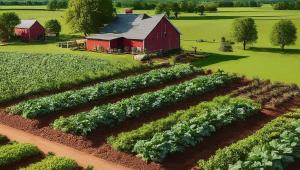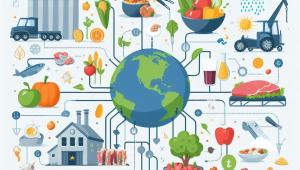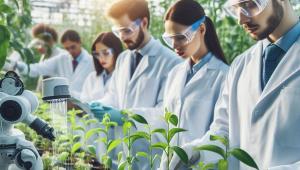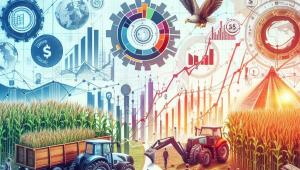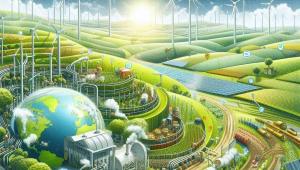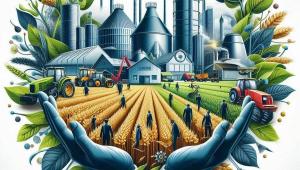Agriculture is a vital sector that plays a crucial role in feeding the world's population, supporting rural livelihoods, and contributing to economic development. However, the agricultural sector is also subject to a wide range of policies and regulations that shape its structure, performance, and sustainability. From farm subsidies and trade agreements to environmental standards and food safety rules, agricultural policies and regulations have far-reaching impacts on farmers, consumers, and society as a whole.
Objectives of Agricultural Policy and Regulation
Agricultural policies and regulations are designed to achieve a variety of objectives, which can sometimes be competing or conflicting. Some of the main objectives of agricultural policy and regulation include:
Food Security and Self-Sufficiency
Ensuring an adequate and stable supply of safe and nutritious food is a primary objective of agricultural policy in many countries. This can involve measures to increase domestic food production, reduce dependence on imports, and manage food reserves and distribution systems. Food security policies may also aim to improve access to food for vulnerable populations, such as through food assistance programs or price stabilization measures.
Economic Development and Rural Livelihoods
Agriculture is a key driver of economic development in many countries, particularly in rural areas where it is a main source of income and employment. Agricultural policies and regulations can aim to promote economic growth and reduce poverty by supporting farm productivity, competitiveness, and market access. This can involve measures such as investment in infrastructure, research and development, extension services, and rural credit and insurance systems.
Environmental Sustainability and Conservation
Agriculture is both a major user and provider of natural resources and has significant impacts on the environment, including soil, water, biodiversity, and climate. Agricultural policies and regulations can aim to promote sustainable and resilient farming practices that conserve and enhance natural resources, reduce pollution and waste, and mitigate and adapt to climate change. This can involve measures such as land use planning, agri-environmental programs, organic and conservation agriculture, and payments for ecosystem services.
Public Health and Food Safety
Ensuring the safety and quality of food is another important objective of agricultural policy and regulation. This can involve measures to prevent and control food-borne illnesses, regulate the use of pesticides and other chemicals, and monitor and trace food products through the supply chain. Public health policies may also aim to promote healthy and sustainable diets, such as through nutrition education, labeling, and procurement programs.
Social Equity and Inclusion
Agricultural policies and regulations can also aim to promote social equity and inclusion, particularly for marginalized and disadvantaged groups such as small-scale farmers, women, and indigenous peoples. This can involve measures to improve access to land, credit, markets, and decision-making processes, as well as to protect labor rights and working conditions in the agriculture sector.
Instruments of Agricultural Policy and Regulation
To achieve these objectives, governments and other actors use a variety of policy and regulatory instruments, which can be broadly categorized into three main types: economic, legal, and informational.
Economic Instruments
Economic instruments use financial incentives or disincentives to influence the behavior of farmers, consumers, and other actors in the agriculture sector. Some common economic instruments include:
Subsidies and Price Supports
Subsidies are payments or other forms of assistance provided by governments to farmers or other actors in the agriculture sector to support their income, production, or competitiveness. Subsidies can take various forms, such as direct payments, input subsidies, or price supports, and can be targeted to specific crops, regions, or groups of farmers. While subsidies can help to stabilize farm income and promote food security, they can also distort markets, encourage overproduction, and have negative environmental and social impacts.
Taxes and Fees
Taxes and fees are charges imposed by governments on specific activities, products, or resources in the agriculture sector, such as land use, water consumption, or pollution. Taxes and fees can be used to generate revenue, internalize external costs, or incentivize certain behaviors, such as the adoption of sustainable farming practices or the reduction of waste and emissions.
Tradable Permits and Quotas
Tradable permits and quotas are market-based instruments that allocate rights or obligations to use or produce certain resources or products in the agriculture sector, such as water, emissions, or production volumes. These rights or obligations can be traded among users or producers, allowing for more efficient and flexible allocation of resources and compliance with environmental or production targets.
Legal Instruments
Legal instruments use laws, regulations, and standards to mandate or prohibit certain behaviors or practices in the agriculture sector. Some common legal instruments include:
Land Use and Tenure Regulations
Land use and tenure regulations govern the allocation, use, and ownership of agricultural land, including zoning, land consolidation, and land reform policies. These regulations can aim to promote efficient and sustainable land use, protect agricultural land from conversion or degradation, and ensure equitable access to land for different groups of farmers and users.
Environmental and Health Regulations
Environmental and health regulations set standards and requirements for the management of natural resources, pollution, and food safety in the agriculture sector. These can include regulations on water use and quality, air and soil pollution, pesticide and fertilizer use, animal welfare, and food processing and labeling. Environmental and health regulations can help to reduce the negative externalities of agriculture and protect public health and ecosystem services.
Labor and Social Regulations
Labor and social regulations set standards and requirements for the rights, protections, and working conditions of agricultural workers and producers. These can include regulations on minimum wages, working hours, health and safety, social security, and freedom of association. Labor and social regulations can help to promote decent work and social inclusion in the agriculture sector, particularly for vulnerable and marginalized groups.
Informational Instruments
Informational instruments use knowledge, communication, and persuasion to influence the behavior of farmers, consumers, and other actors in the agriculture sector. Some common informational instruments include:
Research and Extension Services
Research and extension services generate and disseminate knowledge and technologies to improve the productivity, sustainability, and resilience of agriculture. These services can include public and private research institutions, agricultural universities, and extension agents who work directly with farmers to provide training, advice, and support. Research and extension services can help to drive innovation and adoption of best practices in the agriculture sector.
Certification and Labeling Schemes
Certification and labeling schemes provide information to consumers about the quality, safety, and sustainability attributes of agricultural products. These schemes can be voluntary or mandatory, and can cover various aspects such as organic production, fair trade, animal welfare, or environmental footprint. Certification and labeling schemes can create market incentives for farmers to adopt sustainable and ethical practices, and enable consumers to make informed choices.
Public Awareness and Education Campaigns
Public awareness and education campaigns aim to raise awareness and change attitudes and behaviors related to agriculture and food systems. These campaigns can target various audiences, such as farmers, consumers, policymakers, or the general public, and can cover various topics, such as nutrition, food waste, sustainable agriculture, or rural development. Public awareness and education campaigns can help to build support for agricultural policies and programs and promote more sustainable and equitable food systems.
Impacts of Agricultural Policy and Regulation
Agricultural policies and regulations can have significant and diverse impacts on various aspects of the food system, including production, trade, consumption, and sustainability. Some of the main impacts of agricultural policy and regulation include:
Production and Productivity
Agricultural policies and regulations can have both positive and negative impacts on agricultural production and productivity. On the positive side, policies such as research and development investments, extension services, and input subsidies can help to increase crop yields, improve farm efficiency, and boost overall food production. On the negative side, policies such as price controls, production quotas, and land use restrictions can distort market signals, discourage investment and innovation, and lead to inefficient resource allocation and lower productivity.
Trade and Market Access
Agricultural policies and regulations can also have significant impacts on trade and market access for agricultural products. Policies such as import tariffs, export subsidies, and non-tariff barriers can distort international trade flows, create unfair competition, and limit market access for certain countries or producers. On the other hand, policies such as trade agreements, market information systems, and quality standards can facilitate trade, improve transparency and efficiency, and create new opportunities for farmers and agribusinesses.
Food Security and Nutrition
Agricultural policies and regulations can have important implications for food security and nutrition, particularly for vulnerable and marginalized populations. Policies such as food assistance programs, price stabilization measures, and nutrition education can help to improve access to and affordability of healthy and nutritious foods. However, policies such as crop-specific subsidies, biofuel mandates, and food safety regulations can also have unintended consequences, such as rising food prices, reduced dietary diversity, and food waste and loss.
Environmental Sustainability
Agricultural policies and regulations can have significant impacts on environmental sustainability, both positive and negative. Policies such as agri-environmental programs, organic farming support, and payments for ecosystem services can encourage farmers to adopt more sustainable and resilient practices, such as soil conservation, water management, and biodiversity protection. However, policies such as input subsidies, land clearing incentives, and weak environmental regulations can also lead to negative environmental impacts, such as soil degradation, water pollution, and greenhouse gas emissions.
Rural Development and Livelihoods
Agricultural policies and regulations can have important implications for rural development and livelihoods, particularly for small-scale farmers and rural communities. Policies such as rural infrastructure investments, credit and insurance programs, and farmer organizations can help to improve farm productivity, income, and resilience, and create new opportunities for rural employment and entrepreneurship. However, policies such as land consolidation, mechanization subsidies, and market liberalization can also have negative impacts, such as land dispossession, rural outmigration, and increased inequality and vulnerability.
Challenges and Opportunities for Agricultural Policy and Regulation
Agricultural policy and regulation face several challenges and opportunities in the 21st century, driven by a range of factors such as population growth, climate change, technological innovation, and changing consumer demands. Some of the main challenges and opportunities for agricultural policy and regulation include:
Climate Change Adaptation and Mitigation
Climate change poses significant challenges for agriculture, including rising temperatures, changing precipitation patterns, and increasing frequency and intensity of extreme weather events. Agricultural policies and regulations need to support farmers in adapting to these changes, through measures such as crop diversification, water management, and climate-smart agriculture practices. At the same time, agriculture is also a significant contributor to greenhouse gas emissions, and policies and regulations need to promote mitigation measures such as reduced deforestation, improved soil management, and increased carbon sequestration.
Sustainable Intensification and Agroecology
With a growing global population and increasing pressure on natural resources, there is a need to intensify agricultural production in a sustainable and resilient way. This requires policies and regulations that promote sustainable intensification practices, such as precision agriculture, integrated pest management, and agroforestry, as well as agroecological approaches that harness ecological processes and biodiversity to improve farm productivity and sustainability. Policies and regulations also need to address the social and economic dimensions of sustainable intensification, such as land tenure security, gender equity, and fair prices for farmers.
Food System Transformation and Resilience
The COVID-19 pandemic has highlighted the vulnerabilities and inequities of the global food system, and the need for more resilient and equitable food systems that can withstand shocks and stresses. Agricultural policies and regulations need to support the transformation of food systems towards greater diversity, localization, and circularity, through measures such as shortening supply chains, promoting urban agriculture, and reducing food waste and loss. Policies and regulations also need to address the power imbalances and inequalities in the food system, such as through antitrust enforcement, fair trade policies, and support for small-scale farmers and food workers.
Innovation and Digitalization
Rapid advances in science and technology, such as biotechnology, precision agriculture, and artificial intelligence, are creating new opportunities and challenges for agriculture. Agricultural policies and regulations need to create an enabling environment for innovation and adoption of these technologies, through measures such as research and development investments, intellectual property protection, and digital infrastructure and literacy. At the same time, policies and regulations need to ensure that the benefits and risks of these technologies are equitably distributed, and that they do not exacerbate existing inequalities or create new vulnerabilities.
Multi-Stakeholder Governance and Participation
Agricultural policy and regulation are increasingly shaped by a complex web of actors and interests, including governments, private sector, civil society, and international organizations. There is a need for more inclusive and participatory governance mechanisms that engage diverse stakeholders in the design, implementation, and monitoring of agricultural policies and regulations. This requires policies and regulations that promote transparency, accountability, and dialogue, as well as capacity building and empowerment of marginalized and underrepresented groups, such as small-scale farmers, women, and indigenous peoples.
Case Studies of Agricultural Policy and Regulation
To illustrate the complexity and diversity of agricultural policy and regulation, we present three case studies from different regions and contexts.
The European Union's Common Agricultural Policy (CAP)
The CAP is one of the oldest and most influential agricultural policies in the world, accounting for around 40% of the EU budget. The CAP was established in 1962 with the objectives of increasing agricultural productivity, ensuring a fair standard of living for farmers, stabilizing markets, and ensuring the availability of supplies. Over time, the CAP has undergone several reforms to address challenges such as overproduction, environmental degradation, and rural development.
The current CAP (2021-2027) aims to support farmers in the transition towards more sustainable and resilient agriculture, while also contributing to the EU's climate and environmental goals. The CAP includes a range of instruments, such as direct payments to farmers, market measures, and rural development programs. The CAP also introduces new elements, such as eco-schemes to reward farmers for environmental and climate practices, and a social dimension to ensure fair working conditions and social protection for agricultural workers.
However, the CAP has also faced criticism for its complexity, bureaucracy, and unequal distribution of benefits, particularly to large-scale and intensive farms. There are also concerns about the CAP's impact on developing countries, through distorted trade flows and dumping of subsidized products.
India's National Food Security Act (NFSA)
The NFSA is a landmark legislation that aims to provide food and nutritional security to the most vulnerable and marginalized populations in India. The NFSA was enacted in 2013 and entitles up to 75% of the rural population and 50% of the urban population to receive subsidized food grains under the Targeted Public Distribution System (TPDS). The NFSA also includes provisions for nutritional support to pregnant and lactating women and children under 14 years of age.
The NFSA has had significant impacts on food security and poverty reduction in India, with studies showing improvements in calorie intake, dietary diversity, and health outcomes among beneficiaries. The NFSA has also created a legal framework for the right to food and empowered citizens to hold the government accountable for its implementation.
However, the NFSA has also faced challenges in its implementation, such as leakages and diversion of food grains, exclusion errors in the identification of beneficiaries, and inadequate infrastructure and capacity of the TPDS. There are also concerns about the fiscal sustainability of the NFSA, given its large budgetary requirements and potential distortions in agricultural markets and incentives.
Brazil's Low-Carbon Agriculture (ABC) Plan
The ABC Plan is a policy framework that aims to promote the adoption of sustainable agricultural practices and reduce greenhouse gas emissions in Brazil's agriculture sector. The ABC Plan was launched in 2010 as part of Brazil's National Climate Change Policy and sets targets for the adoption of low-carbon technologies such as no-till farming, planted forests, and integrated crop-livestock-forestry systems.
The ABC Plan includes a range of instruments, such as credit lines, technical assistance, and research and development programs, to support farmers in the transition towards low-carbon agriculture. The ABC Plan also aims to improve the productivity and competitiveness of Brazilian agriculture, while conserving natural resources and biodiversity.
The ABC Plan has had positive impacts on the adoption of sustainable agricultural practices in Brazil, with studies showing increases in the area under no-till farming, planted forests, and integrated systems. The ABC Plan has also contributed to Brazil's climate change mitigation efforts, with estimates of avoided emissions of up to 170 million tons of CO2 equivalent by 2020.
However, the ABC Plan has also faced challenges, such as limited uptake by small-scale and family farmers, weak monitoring and enforcement mechanisms, and competition with other land uses such as deforestation and cattle ranching. There are also concerns about the social and environmental impacts of some of the technologies promoted by the ABC Plan, such as the use of genetically modified crops and agrochemicals.
Conclusion
Agricultural policy and regulation are complex and multifaceted issues that have far-reaching impacts on food security, rural livelihoods, environmental sustainability, and social equity. As we have seen, agricultural policies and regulations involve a range of objectives, instruments, and actors, and are shaped by diverse political, economic, and social contexts.
To address the challenges and opportunities of the 21st century, agricultural policies and regulations need to be more adaptive, inclusive, and transformative. This requires a shift towards more systems-based and participatory approaches that engage diverse stakeholders in the co-creation and co-implementation of policies and programs.
